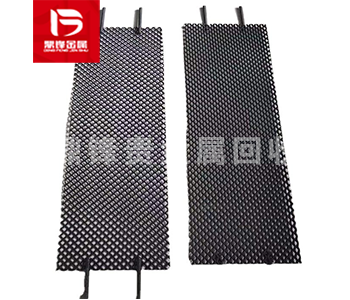
Ruthenium Iridium Mesh Recycling
Ruthenium iridium mesh is a metal mesh material made of an alloy of ruthenium (Ru) and iridium (Ir), which is widely used in the fields of catalysis and electrocatalysis. It combines the excellent chemical stability, electrical conductivity and high temperature resistance of ruthenium and iridium, and is often used in catalytic reactions in high temperature and highly corrosive environments such as hydrogen production, fuel cells, etc. The mesh structure increases the surface area and improves catalytic efficiency. Ruthenium-iridium mesh plays an important role in reactions such as ammonia synthesis and is a key material in some high-end technologies. Waste ruthenium-iridium mesh is one of the recycling sources of ruthenium-containing waste. Other recycling sources of ruthenium-containing waste include ruthenium wire recycling, ruthenium sheet recycling, ruthenium slag recycling, ruthenium particle recycling, ruthenium ingot recycling, ruthenium powder recycling, and ruthenium-iridium-titanium mesh recycling.
- Parameter
- Related Questions and Answers
-
Name : Ruthenium Iridium Mesh
-
Use : Catalysts, high-temperature catalytic reactions, etc.
-
Application Areas : Industry Sector
-
Appearance and properties : Metal mesh
-
Settlement Method : On-site payment
-
Recycling Type :Ruthenium recycling
-
Door-to-door recycling:worldwide
-
Customer service: Free content testing and door-to-door recycling
Ruthenium Chloride Recycling
Ruthenium chloride (RuCl₃) is a compound consisting of ruthenium and chlorine, usually in the form of black or dark green crystals or powder. It is a common compound of ruthenium and is widely used in catalytic reactions, especially in processes such as organic synthesis and hydrogen production. Ruthenium chloride has good thermal stability at high temperatures and strong catalytic activity, so it is often used as a catalyst or catalyst precursor. It can also be used in the production of ruthenium metal and as a raw material for ruthenium-based alloys and materials. Ruthenium chloride is also used in fuel cells, electrocatalysis, certain chemical analyses, and materials science research. Waste ruthenium chloride is one of the recycling sources of ruthenium-containing precious metal catalyst waste. Recycling of ruthenium-containing precious metal catalyst waste also includes ruthenium oxide recycling, ruthenium acetate recycling, ruthenium carbon recycling, ruthenium zinc catalyst recycling, ruthenium iodide recycling, ruthenium aluminum oxide catalyst recycling, etc.
Search : Ruthenium Chloride RecyclingRuthenium Powder Recycling
Ruthenium powder refers to a fine particle material made of ruthenium metal, usually black or gray in color. It is a solid of ruthenium obtained in the process of refining or grinding, and has a large specific surface area, so it has strong chemical reactivity. Ruthenium powder has important applications in many industrial and scientific research fields, especially in catalysis, electronics, chemical synthesis, etc. Ruthenium powder has excellent catalytic properties, so it is widely used in the manufacture of catalysts, especially in hydrogenation and oxidation-reduction reactions. Ruthenium powder can also be used to manufacture high-end products such as ruthenium-based alloys, electrode materials, hard disks, and electronic components. Ruthenium powder is usually produced by chemical reduction or physical deposition. To meet the requirements of different fields, the particle size and purity must be controlled during the production process.
Search : Ruthenium Powder RecyclingRuthenium Alumina Catalyst Recycling
Ruthenium alumina catalyst is a catalyst that combines ruthenium metal with alumina (Al2O3) support. As a carrier for ruthenium, alumina provides a larger surface area, stabilizes the dispersion of ruthenium metal, and enhances the efficiency of catalytic reactions. Ruthenium alumina catalysts are widely used in chemical reactions such as hydrogenation, catalytic cracking, oxidation reactions, and synthesis gas conversion. Ruthenium has excellent catalytic activity, especially in hydrogenation and oxidation-reduction reactions, so ruthenium alumina catalysts can effectively improve the reaction rate and selectivity. Ruthenium alumina catalysts also have important applications in the fields of petrochemicals, environmental protection, and energy, especially in gas refining and clean energy production. Waste ruthenium alumina catalysts are one of the sources for recycling ruthenium-containing precious metal catalysts. Other sources for recycling ruthenium-containing precious metal catalysts include recovery of ruthenium iodide, recovery of ruthenium chloride, recovery of potassium ruthenium chloride, recovery of ruthenium oxide, and recovery of ruthenium trichloride.
Search : Ruthenium Alumina Catalyst RecyclingRuthenium Slag Recycling
Ruthenium slag refers to the solid waste or residues produced after ruthenium metal reacts with other substances during the smelting, refining, or use of ruthenium. As ruthenium is a precious metal, it is usually smelted under conditions of high temperature and pressure. Therefore, ruthenium slag often contains small amounts of other metallic impurities, such as iridium and platinum, in addition to ruthenium. The composition and properties of ruthenium slag may vary depending on the specific process by which it is produced, and it usually needs to be recovered and processed in a specific way to extract the ruthenium and other precious metals it contains. Ruthenium slag may also be used as a by-product in catalysis in some cases, or chemically processed to produce other ruthenium alloy materials. Waste ruthenium slag is one of the recycling pathways for ruthenium-containing waste. Other recycling pathways for ruthenium-containing waste include ruthenium water recycling, ruthenium slurry recycling, ruthenium slag recycling, ruthenium powder recycling, ruthenium gold recycling, ruthenium wire recycling, and ruthenium block recycling.
Search : Ruthenium Slag RecyclingProduct Details
ルテニウムイリジウムメッシュは、ルテニウム(Ru)とイリジウム(Ir)の合金で作られた金属メッシュ材料であり、触媒や電気触媒の分野で広く使用されています。ルテニウムとイリジウムの優れた化学的安定性、導電性、高温耐性を兼ね備えており、水素製造、燃料電池などの高温・高腐食環境での触媒反応によく使用されます。メッシュ構造により表面積が大きくなり、触媒効率が向上します。ルテニウム-イリジウムメッシュは、アンモニア合成などの反応において重要な役割を果たしており、一部のハイエンド技術における重要な材料です。
ルテニウムとイリジウムメッシュの比率は、通常、さまざまな触媒用途の要件に応じてカスタマイズされます。ルテニウムとイリジウムの比率が異なると、触媒の活性、安定性、耐高温性、耐腐食性、コストに影響します。以下に、一般的な比率の種類とその詳細な説明を示します:
1.90% ルテニウム / 10% イリジウム (Ru90Ir10): 90% ルテニウム / 10% イリジウム ルテニウム含有量が高いイリジウム メッシュは、優れた触媒活性を発揮し、特に水素生成や燃料電池などの低温触媒反応に適しています。この比率ではイリジウム含有量が低くなるためコストを低く抑えることができ、触媒の高温および腐食に対する耐性もある程度向上しますが、極度に高温の条件下での安定性はわずかに低下します。その利点は、反応効率が高く、中低温条件下での化学反応に適していることです。
2.80% ルテニウム / 20% イリジウム (Ru80Ir20): 80% ルテニウム / 20% イリジウム ルテニウム イリジウム メッシュは、触媒反応においてルテニウムの高い活性とイリジウムの優れた安定性を提供します。主成分であるルテニウムは、特に低温および中温触媒反応において強力な触媒性能を発揮します。イリジウム含有量が多いほど、この比率のルテニウム - イリジウム メッシュは高温環境でより安定し、耐酸化性と耐腐食性が強くなります。そのため、このルテニウムとイリジウムの比率のメッシュは、アンモニア合成、石油分解などの高温触媒反応、特に燃料電池の電気触媒反応に広く使用されており、高負荷や長期使用でも安定性を維持できます。イリジウムの増加によりコストは増加しますが、その強力な高温耐性と安定性により、このルテニウム - イリジウム メッシュ比率は高温産業用途において大きな利点を持ちます。
3.70% ルテニウム / 30% イリジウム (Ru70Ir30): 70% ルテニウム / 30% イリジウム ルテニウム イリジウム メッシュは、高温および強い腐食環境で優れた性能を発揮し、特に極端な条件下での触媒反応に適しています。ルテニウム含有量は比較的低く、主にイリジウムが優れた耐高温性と耐酸化性を提供するため、この比率のルテニウム - イリジウム メッシュは高温触媒反応において特に安定しています。たとえば、高温水素製造、燃料電池、および特定の特殊化学合成反応では、イリジウムの割合が高いと触媒の耐用年数が延び、過酷な条件下での耐腐食性が向上します。コストは高くなりますが、優れた耐久性と高温安定性により、このルテニウムとイリジウムのメッシュ比率は、特に長期にわたる安定した動作を必要とする工業用触媒反応などの高温用途で非常に人気があります。
廃棄ルテニウム-イリジウムメッシュは、ルテニウム含有廃棄物のリサイクル源の1つです。ルテニウム含有廃棄物の他のリサイクル源には、ルテニウムワイヤリサイクル、ルテニウムシートリサイクル、ルテニウムスラグリサイクル、ルテニウム粒子リサイクル、ルテニウムインゴットリサイクル、ルテニウム粉末リサイクル、ルテニウム-イリジウム-チタンメッシュリサイクルなどがあります。ルテニウム含有スクラップのリサイクルが必要な場合は、当社の 24 時間対応サービス ホットラインにお電話ください。鼎锋貴金属リサイクルおよび精製メーカーは、利益の差を生む中間業者を排除した独立したリサイクルおよび精製工場を備えており、専門の技術チームと顧客サービス担当者が 1 対 1 のサービスを提供し、リサイクル プロセス中の顧客のプライバシーを確保します。

